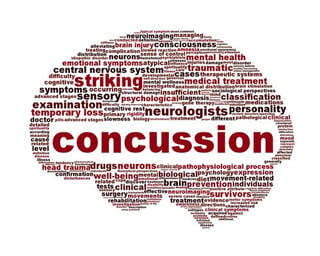 From the big screen, to NFL fields, to high school gymnasiums across the country, the buzz about concussions is getting louder. Just as our awareness is increasing, our tools for evaluation are improving. So is our understanding of why it’s important to give students the time they need to fully recover. Their futures depend on it!
From the big screen, to NFL fields, to high school gymnasiums across the country, the buzz about concussions is getting louder. Just as our awareness is increasing, our tools for evaluation are improving. So is our understanding of why it’s important to give students the time they need to fully recover. Their futures depend on it!
Concussion rates represent a high proportion of all injuries sustained by athletes. In the United States, an estimated 3.8 million concussions occur each year as a result of sport and physical activity.
Schools, parents, and physicians want to work together to keep students safe while they play hard and have fun. That’s why there is greater emphasis on information and prevention, knowing each student’s baseline, and responding swiftly and cautiously when concussions occur. Here are some best practices to consider.
Before and During Play
Prior to the start of the athletic season, it is a good idea for all student-athletes to take a baseline concussion test. Either a physician or knowledgeable athletic trainer can perform this evaluation.
If a suspected concussion occurs during a practice or game, an athletic trainer should remove the athlete from play/competition or physical activity. They should move to a quiet space, so that the athletic trainer can properly evaluate symptoms. At this stage, the athletic trainer should notify parents of the findings and make any necessary referrals.
Signs and Symptoms
Recognition is key. Knowing the signs and symptoms of concussion and being aware of changes in your child’s behavior is crucial to a swift recovery. Watch for:
- Headaches
- Difficulty concentrating and/or remembering
- Dizziness, lightheadedness, balance problems
- Sensitivity to light and/or noise
- Feeling in a daze, sluggish, or foggy
- Vision problems, double-vision
- Sleep difficulties
- Fatigue
- Irritability, sadness, and/or nervousness
- Nausea
Take Action
Your doctor will likely monitor your child’s condition at the time of the injury and during the recovery phase. Some clinics and hospitals even have specialized Concussion Clinics that offer a team approach to assessing patients and monitoring their recovery.
What should you do if you know or suspect that your child has a concussion?
- Seek medical evaluation and treatment if you haven’t already.
- Observe your child carefully for new symptoms or worsening of symptoms.
- If you notice an increase in the number or the severity of symptoms, seek immediate medical help.
A phone call to your child’s doctor can be helpful in determining the next steps for treatment. The American Academy of Pediatrics states that children need an average of 3+ weeks’ complete recovery time after a concussion, but most primary symptoms resolve in 7-10 days.
Recovering from a Concussion: Pace Yourself
Brain cells repair themselves daily, so the effects of the concussion should become more tolerable over time. Pay close attention to symptoms after short periods of cognitive exertion in order to evaluate the recovery process. Your child’s doctor will indicate when it is time for your child to return to school, but plan to do so gradually and carefully.
Return to Learn
It’s common for a concussion to disrupt a child’s ability to think, concentrate, remember, and process new material efficiently. Doing too much too soon may worsen concussion symptoms and perhaps even prolong recovery, so let symptoms guide the plan to return to school. Expert guidelines suggest that a child can usually return when symptoms are tolerable for 30-45 minutes.
A good school concussion policy considers safety first and foremost. The goal during recovery is to avoid overexerting the brain and worsening symptoms. Here are suggested steps to follow, once a physician gives the okay:
- Plan to return to school gradually, such as half days as tolerated.
- Parents: work with the school counselor to determine a plan for return based on the child’s daily class schedule.
- Students: observe class and avoid note-taking and the use of computer upon return. Why? The school environment can trigger symptoms, such as noise in the dining hall or other environmental factors.
- Students in recovery: check in with the school counselor or school nurse during the day to assess symptoms. Rest if you need to; your long-term health depends on it!
Return to Play
Returning to school does not mean returning to play at the same time. Returning to play also has a set of specific guidelines. Each step must be successfully completed, and the student-athlete must be symptom free for 24 hours before progressing to the next step.
- Step One: Light aerobic exercise
- Step Two: Sport-specific exercise
- Step Three: Non-contact training drills
- Step Four: Full contact practice
- Step Five: Return to play/ Normal game play
Remember that pre-season baseline evaluation? Students should be performing at their academic baseline before returning to sports, full physical activity, or other extracurricular activities following a concussion. Also, it should be required that the child’s doctor provide documented permission to return to athletic activity.
At Sanford School, we are firmly committed to ensuring that our student-athletes get the time and accommodations they need to make a full recovery from all injuries that may occur during physical activity or sports. Their present and future well-being relies on it, so we strive to follow guidelines from the AAP and the CDC. We also make sure our students, parents, and coaches are well informed about concussions and their risks.
For additional information, please visit:
- Heads Up Concussion Fact Sheet for Parents from the CDC
- Sports-Related Concussions: Understanding the Risks, Signs & Symptoms from the American Academy of Pediatrics
- After a Concussion: When to Return to School from the American Academy of Pediatrics
- The National Athletic Trainers Association Position Statement on the Management of Sports Concussion
Staci Krape teaches science at Sanford School in Hockessin, Delaware. Lauren Ziady is the former Guidance Counselor and Learning Services Coordinator at Sanford School.








